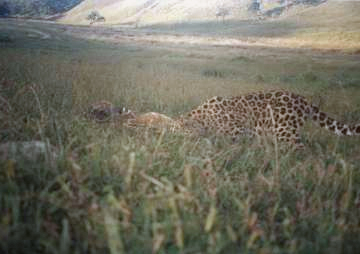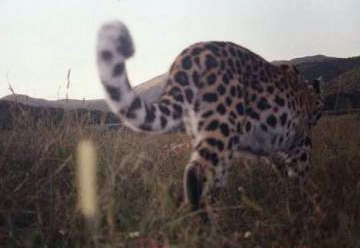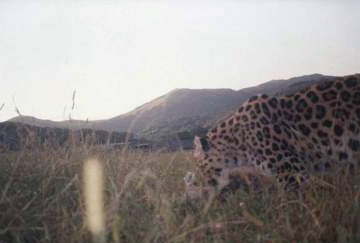Rare Amur leopard photographed for the first time with kill
Jeremy Hance, mongabay.com
October 9, 2008
With just over thirty individuals left, every photograph of an Amur leopard in the wild is news. But recently released photos are the first to show an Amur leopard at a livestock kill, making them even more important.
According to an article from Wildlife Alliance, on September 8th a staff member of the Gamov sika deer farm contacted Eugene Stoma with news about an Amur leopard that had entered the farm and killed three deer. Stoma is the leader of an anti-poaching squad that protects the remaining leopards.
After locating the leopard’s kill, a mature female deer with lacerations on its neck and head, Stoma and his team placed camera traps around the kill, hoping the leopard would return. Writing on the website of The Amur Leopard and Tiger Alliance (ALTA), Stoma explains that he was waiting for a chance like this.
   Photos courtesy of the Phoenix Fund, Wildlife Alliance, and Eugene Stoma |
“For some time I have been planning to take photos of leopards and tigers with camera-traps. The big cats often return to their kills for a second meal, so I assumed that it was possible to take photos of the cats with cam-traps placed at livestock kills. The problem was that our team doesn’t own cam-traps and there was no budget available that made it possible to buy them. Fortunately, our partners at [the Wildlife Conservation Society (WCS)] helped out.” WCS loaned Stoma and his team four cameras.
The leopard did return yielding three photos from various angles. “I am very happy with this result,” Stoma writes. “Both sides of the leopard are visible, and this means it will be possible to identify this leopard if it appears in cam-trap photos in the future. It is impossible to determine the sex of the leopard with certainty from the photos, but the leopard is slender and elegant. If I would have to guess, I would say it is a female. Maybe her cub waited in the distance until she had moved her kill away from the logs and camera-traps, but we will never know!”
The Gamov deer farm is a supporter of the critically-endangered leopard. They participate in a compensation program which reimburses them for any livestock killed by an Amur leopard or Siberian tiger (which inhabits the same region). The Gamov farm is one of three deer farms in the leopard’s habitat, located in the far south-east of Russia along the Amur River. The sika deer are raised for the velvet on their antlers, which is an ingredient in some Chinese medicines.
“The deer at the farms form a welcome additional food source for leopards and tigers,” Stoma explains. The leopards often have difficulty finding food since their prey has been largely poached in the area. This time the compensation program worked, benefiting leopards, biologists, and the Gamov farm.
ALTA – Amur Leopard and Tiger Alliance
Wildlife Alliance – Russia